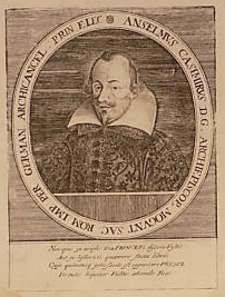On 7 October, 2014, Künker auctions off the Horn Collection. It contains cimelia not just of the European but the German coinage as well.
Mainz. Anselm Casimir Wamboldt von Umstadt (1629-1647). Thick triple reichsthaler 1639, Mainz. From Horn Collection, Meißen. Of great rarity. Very fine. Estimate: 20,000 euros.
Anselm Casimir, by the grace of God, Archbishop of Mainz, Chancellor for Germany in the Holy Roman Empire, Prince, Prince-Elector – this is how the Latin inscription translates on the obverse of a thick triple reichsthaler from the Bishopric of Mainz, issued in 1639. This inscription is important. If we did not know that the man depicted was one of the most influential princes of the church, we would never have guessed it by the look at the portrait alone. Anselm Casimir wears a gorgeous garment, lavishly embroidered with flowers. He is bare-headed and does not hold any insignia of an official function in his hands.
Bishop’s coat of arms. Source: Wikipedia.
The reverse, that is lacking any text, exhibits the bishop’s coat of arm: the Wheel of Mainz and the family coat of arms with the five silver peaks. It is crowned by three helmets the middle one of which is adorned with the tiara of the Archbishop. Behind the coat of arms the badges of both the secular and the churchly power are depicted: the sword and the episcopal crozier. A particularly noteworthy element is the laurel wreath that surrounds this depiction. It recalls the honor a highly talented poet could be conferred on. And although the history of German literature does not mention Anselm Casimir Wamboldt von Umstadt, his contemporaries considered him the German Cicero thanks to his great rhetorical skills.
Anselm Casimir. Source: Wikipedia.
Anselm Casimir was born in 1579 as the son of Eberhard Wambolt von Umstadt. His father belonged to the lesser nobility and earned his living as an assessor at the Reichskammergericht at Speyer. Probably the most extraordinary thing he did in his life was his conversion from Calvinism to Catholicism – very likely he acted from conviction, because he had little Anselm Casimir been raised in the spirit of the Counter Reformation. That also included the visit to the Jesuits’ grammar school, a two-year education at the Collegium Germanicum in Rome as well as the study of Theology and Jurisprudence. The top-notch training paid off. When Anselm Casimir was 26 years of age, he was admitted to the Mainz cathedral chapter.
To Mainz, Anselm Casimir was a piece of luck. After all, chronologically speaking, we are heading towards the 30 Years’ War. Envoys and ambassadors went from court to court to represent the interests of their masters. It was left to Anselm Casimir to represent the interests of the archdiocese of Mainz: at the imperial court, at the Kurfürstentag, in the recatholisation of Eichsfeld. He even acted as proxy when the prince-bishop was absent. When the latter died in 1629, Anselm Casimir easily won the election and became his successor.
The new archbishop vigorously supported the policy of the Catholic Hapsburgs, to the disadvantage of Mainz. Gustavus Adolphus took the city in 1631. Anselm Casimir fled to Cologne and returned as late as 1636 to a destitute and plundered Mainz. It was that year that he let himself be ordained to the priesthood, at the age of 57. He had a very good reason for this: Ferdinand III intended to turn to him for being crowned as king and not to the Cologne archbishop.
The Emperor may have done so out of gratitude for the support Anselm Casimir had provided. The latter’s hard-edge adherence to the positions of the Hapsburgs, however, became something of an obstacle to the peace treaties that were to end the 30 Years’ War. The German Cicero did not live long enough to witness the Peace of Westphalia being signed. During his exile at the city of Frankfurt – which he had to flee to since Mainz was occupied by the French – he died on 9 October 1647.









